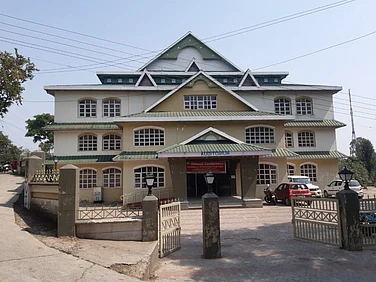There has been an institutional displacement of the Adivasis, Dalits, and Minorities for decades in Jharkhand. Daily wage earners and laborers have migrated from nearby districts and states to the cities in search of livelihood and shelter- the cities whose foundation stand on their labor and sweat. However, it is the city and the administration which has deprived this section, comprising the Adivasis, Muslims, and Dalits, of something as basic as roof over their heads. The number of homeless and evictees has only increased post lockdown, while the state machinery refuses to acknowledge their growing challenges and problems.
While the entire state of Jharkhand falls under the CNT (Chhotanagpur Tenancy) Act 1908, companies and states have found loopholes and had their way, usurping tribal lands and carrying out development projects. But the Adivasis, Dalits, and Muslims whose lands are taken by the state are nowhere in this picture of development as you see them crammed in slums, roadside pavements, and temporary shelters; sleeping under the bare sky.
These laborers and daily wage earners built their homes in Ranchi about 50-60 years ago. They settled near bus stands and railway stations for keeping in mind the accessibilities and transportation-related facilities. Even 22 years after the formation of the separate state, they are being rendered homeless.
Firstly, they lost their jobs and daily wages due to the pandemic and covid induced lockdown. While they were struggling to keep the firewood burning in their houses, the administration further added to their woes by razing their homes and carrying out evictions in the middle of one of the worst cold waves. This is not just an eviction of people, but an appalling eviction of human values.
Most of the evictees of the 28th December demolition by the railways in Ranchi are Adivasis, Dalits, and single mothers. Women whose livelihoods depended on working as domestic workers and construction site laborers are now left to fend for themselves without a roof or four walls- further exposing them to violence and crimes. The state government did not compensate them or provide them with a habitable place to live. Moreover, it must be noted that the railway land belongs to the Centre and neither the Centre nor the railways devised a solution for the now homeless evictees, a disastrous failure of the system and government. Those who had managed to find full-time work close to their homes are now back on the streets looking for work, skill development, and money.
The state has further pushed the marginalized sections of society to poverty-inducing cleavages, forcing them to live in slums, or by footpath as they no longer have a place to call home. Cities keep developing and expanding, while villages are destroyed. It is the marginalized poor, Adivasis, Muslims, and Dalits upon whose lands, the dreams of real estate and miners flourish. But does the state make any arrangements to make the lives of the labour class any easier?
Post lockdown, the state labour department initiated organizing the labour and migrant class. Shram cards were introduced to enroll labourers under the department, but that even turned out to be another government failure. When their houses were razed, the department didn't bother to find the whereabouts of the workers and intra-state migrants, once again Adivasis, poor Muslims, and Dalits. The labour department must be questioned about what it is doing if not bothered about workers sleeping on footpaths, awaiting a road accident.
Multiple housing projects have been initiated by both the state and consecutive union governments including the Prime Minister Awas Yojana, Ambedkar Awas Yojana, Birsa Awas Yojana, and Indira Gandhi Awas Yojana. However, it is both interesting and sad to note that the slum dwellers have not been connected with these yojanas(projects). Intra-state migration reflects that those who have been displaced in villages have not been rehabilitated by the government, thus forcing the rural populations to swarm into the city vicinities.
In 2012, the government of Jharkhand decided to take away 227 acres of agricultural land from its Adivasi owners in order to set up the Ranchi campuses of IIM, IIT, and the National University of Study and Research in Law (NURSL) in Nagri, situated in the outskirts of Ranchi city. The government claimed to have acquired the 227 acres in 1957–58 for an expansion of the Bisra Agricultural University under the Land Acquisition Act of 1894. Of 153 raiyats (tenants), only 25 had accepted payment at the time, while a large majority of 128 refused to sell, thus giving rise to the Nagri movement.
The Nagri movement was led by Adivasi women and was an example of the state's acquisition of minorities' lands and displacement. Those who were displaced by one of the flagship projects of Independent India, Heavy Engineering Corporation (HEC), are till the date fighting for their dues after over 60 years of the project. Such instances are just a few to name and the long list continues to grow even after 75 years of India's independence. Moreover, there are no government figures for such displacements and those affected by them.
What is happening is not just the eviction of people but a repeated attack on the culture, civilization, and tradition of the Adivasis, Dalits, and Muslims.
The Jharkhand government has set up an Ashray centre, and temporary tents on Ranchi's Main road, for the homeless and evictees, to safeguard them from cold. But this cannot be a permanent solution. Colonies in Ranchi's Harmu remain vacant while people are sleeping on the roads. The government should have these houses repaired and settle the evictees.
The Alappuzha trains from Dhanbad carry thousands of young Adivasis and Dalits from the state every day to the south. Crammed in the train bogies, the youth in search of livelihood and shelter is forced to go to a different corner of the country from the steel city Bokaro and mining hub Dhanbad. Why is the government adamant about not making the aboriginals and locals a shareholder in the royalty and profits of all government and companies' ongoing projects? Why are we homeless in our own homeland? Why are we not empowered to build our own homes? And why are our homes taken away when we make one?
My son, a budding tribal journalist, and activist, Tirth Nath Akash once accurately put this together, "the government shifts for development where the brahmins, upper caste, and upper class settle. And in turn, these development projects shift the Adivasis, Dalits, Muslims and poor away from the vicinity of the development".
The government must wake up to the status and rising number of homeless people amid an alarming climate change. The District Collector and state machinery must formulate policies and fix a budget for the proper and effective rehabilitation of the targeted evictees immediately.
Views expressed are personal- (As told to Swati Shikha)
Aloka Kujur is a tribal activist and journalist based in Ranchi, Jharkhand. She works on tribal, women, and human rights cases, and is affiliated with the Jharkhand Janadhikar Mahasabha.





















